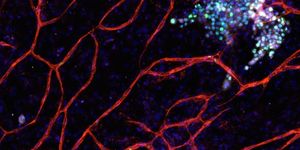Is visual input essential to how the topographical map of the visual cortex develops in the human brain?
In new research, scientists at the Hebrew University of Jerusalem and in Germany and the USA show that the way in which the brain organizes its visual sense remains intact even in people who are blind from birth, and that at least the pattern of functional connectivity between the visual area and the topographical representation of space (up/down, left/right, etc.) can develop on its own without any actual visual experience.

The findings, reported in the peer-reviewed neuroscience journal Brain, dispel the nearly half-century belief that the visual cortex -- the area of the brain concerned with the sense of sight -- completely fails to develop properly in people who are blind at birth, suggesting it might not be completely correct.
"Though the 'blind brain' wiring may change greatly in the blind in its frontal language related parts, it still retains the most fundamental topographical and functional connectivity organizational principles of the visual cortex, known as 'retinotopic mapping' -- the processing of two-dimensional visual images through the eye," said co-lead researcher Amir Amedi, associate professor of medical neurobiology at the Hebrew University's Edmond and Lily Safra Center for Brain Sciences and IMRIC, the Institute for Medical Research Israel-Canada.
Operating within the Hebrew University's Faculty of Medicine, IMRIC coordinates research within the departmental areas of medical neurobiology, molecular genetics and biology, immunology and cancer research.
The researchers found that the same "mapping" divisions-of-labor present in the normally sighted brain are also present in the brains of people born blind as reflected from their resting state connectivity patterns. This fundamental organization of the visual cortex was even found in people whose eyes did not develop normally, suggesting normal eye development may not be necessary for the establishment of large-scale functional connectivity network mapping in the most fundamental visual areas like V1, the primary visual cortex.
Contrary to conventional wisdom, the latest findings reported by Prof. Amir Amedi, Dr. Ella Striem-Amit and Smadar Ovadia-Caro suggest that some key features and properties of visual cortex organization do not require visual experience to progress. The study further adds that the brain's visual cortex does not lose all of its properties even when completely deprived of vision.
"Some of the brain's connectivity maps is hardwired, possibly dependent on genetically-driven processes that do not need any external sensory information for their activation, while other process might indeed need visual input to specialize," Amedi said. The visual brain resting-state connectivity networks separated to up vs. down, right vs. left, front vs. back are also present in the brain of those born blind, according the study.
Follow Will Hector: @WriteCompassion
(Sources: The Hebrew University of Jeruselum; Science Daily)









